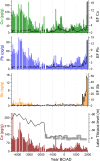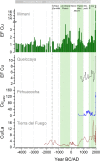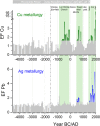Ice-core evidence of earliest extensive copper metallurgy in the Andes 2700 years ago
- PMID: 28139760
- PMCID: PMC5282569
- DOI: 10.1038/srep41855
Ice-core evidence of earliest extensive copper metallurgy in the Andes 2700 years ago
Abstract
The importance of metallurgy for social and economic development is indisputable. Although copper (Cu) was essential for the wealth of pre- and post-colonial societies in the Andes, the onset of extensive Cu metallurgy in South America is still debated. Comprehensive archaeological findings point to first sophisticated Cu metallurgy during the Moche culture ~200-800 AD, whereas peat-bog records from southern South America suggest earliest pollution potentially from Cu smelting as far back as ~2000 BC. Here we present a 6500-years Cu emission history for the Andean Altiplano, based on ice-core records from Illimani glacier in Bolivia, providing the first complete history of large-scale Cu smelting activities in South America. We find earliest anthropogenic Cu pollution during the Early Horizon period ~700-50 BC, and attribute the onset of intensified Cu smelting in South America to the activities of the central Andean Chiripa and Chavin cultures ~2700 years ago. This study provides for the first time substantial evidence for extensive Cu metallurgy already during these early cultures.
Conflict of interest statement
The authors declare no competing financial interests.
Figures






References
-
- Lechtman H. The Inka, and Andean metallurgical tradition. In Variations in the Expression of Inka Power (eds Burger R. L., Craig M., Mendieta R. M.) 313–355 (Dumbarton Oaks, Washington, DC, USA 2007).
-
- Burger R. L. & Gordon R. B. Early central Andean metalworking from Mina Perdida, Peru. Science 282, 1108–1111 (1998). - PubMed
-
- Lambert J. B. Traces of the past: Unraveling the secrets of archaeology through chemistry (Addison-Wesley, Boston, 1997).
-
- Lechtman H. Issues in Andean metallurgy. In Pre-Columbian metallurgy of South America (eds Benson E. P.) 1–40 (Dumbarton Oaks, Washington, DC, USA, 1979).
-
- Alunni A. I. A study investigating copper smelting remains from San Bartolo, Chile. Bachelor Thesis, Massachusetts Institute of Technology, Cambridge (2006).
Publication types
LinkOut - more resources
Full Text Sources
Other Literature Sources

